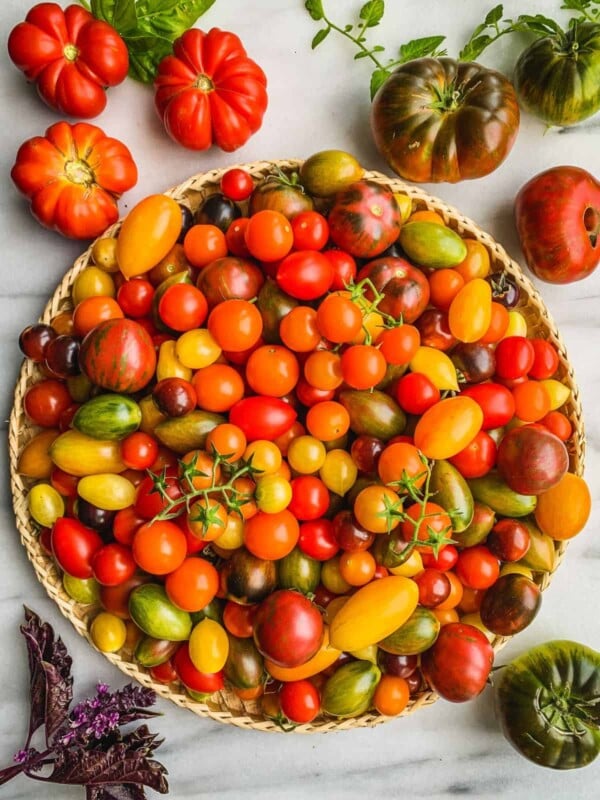Cabbage belongs to the Brassicaceae family, which also includes broccoli, cauliflower, and Brussels sprouts. This post will cover a range of topics including varieties, how to grow cabbage, harvest, store, preserve and enjoy.

Table of Contents
Cabbage Overview
Cabbage is native to the Mediterranean but grown all over today; it is hardy and adaptable to different climates. It is a staple food in many cultures due to its versatility, long shelf life, and nutrition.
Cabbage has symbolic significance, often associated with luck, prosperity, and positive symbolism. Cabbage dishes are served during festivals and celebrations as symbols of abundance and blessings. Additionally, some cultures associate it with rejuvenation and new beginnings, particularly during seasonal celebrations.
Cabbage is thought to have anti-inflammatory and antioxidant properties, is low in calories, and is rich in nutrients such as vitamin C, vitamin K, folate, and dietary fiber.
Culinary Uses
Cabbage is extremely versatile, with many culinary applications. It adds a great texture and sweetness when used fresh in salads and slaws. Try my Winter Coleslaw or Dolly Parton’s Coleslaw Recipe.

It can also be cooked in soup or stew, braised, or added to casseroles. It is commonly fermented, either as sauerkraut (try my homemade sauerkraut and red cabbage sauerkraut) or kimchi, and added as a condiment to many dishes.
Cabbage can be stir-fried or sautéed, stuffed for cabbage rolls, or pickled for a crunchy and flavorful addition to sandwiches and charcuterie boards.
Cabbage Varieties
There are several varieties of cabbage, each with unique characteristics in terms of flavor, texture, and appearance. Some common varieties include:
- Green cabbage is the most common and recognizable variety. It has a round shape with tightly packed, smooth leaves. It has a mild flavor and is often used in sauerkraut.
- Red cabbage is named for its bright color but is similar in flavor and growth habit to green cabbage.
- Savoy cabbage has crinkled leaves that are more delicate than other cabbages. It has a slightly milder flavor than the green variety. It is commonly used for stuffed cabbage rolls, soups, and stir-fries.
- Napa cabbage is sometimes called Chinese cabbage. It differs from other cabbages with elongated rather than round heads. It has wrinkled, delicate leaves similar to the savoy variety. It is commonly used in Asian cuisines like kimchi, stir-fries, and soups.
- Pointed Cabbage is a variety of green or red cabbage that grows in a pointed or cone shape. The are often only available at farmer’s markets.

Growing Cabbage in Small Gardens and Container Gardens
While you can grow cabbage in a small space or a container, it takes up a significant amount of garden space per head. Often, each head needs a minimum of 1.5 square feet, with many varieties requiring up to four.
If you want to grow cabbage in a smaller space, consider the variety you choose. Several varieties, such as Tiara, Katarina, or Pixie, are bred specifically for their smaller size and take much less space than larger traditional options.
If you are growing cabbage in a container, it is important to choose one large enough to support its growth; a five-gallon pot would be a good starting point. Start with nutrient-dense soil and fertilize consistently to ensure that it gets enough nutrition. Make sure to water consistently. See my dedicated post on growing in containers.
When to Plant
Cabbage prefers cooler temperatures and grows best in a Spring or Fall garden (and winter garden in milder regions). Start seeds for spring planting 6-8 weeks before your last frost, then harden off and transplant out as soon as 1-2 weeks before your last frost.
However, pay attention to your forecast, as cabbage exposed to prolonged cooler temperatures (less than 40-45°F) can get severely stunted or even bolt without forming a head. Harvest them before the heat of summer, when they will also bolt.
You can do a second planting in the fall. Start seeds inside mid-summer and transplant outside as temperatures start to cool. To extend your harvests, you can start different varieties with various dates to maturity. This will provide consistent harvests without the need for succession planting. Some varieties, such as the January King, are bred for winter cropping and will keep in the garden through minor frosts.
A note that my book Seed to Table includes a Cabbage Crop Guide and also covers seed starting, plant maintenance and more.

How to Plant
It is best to start cabbage seeds indoors or in a greenhouse or buy transplants from a nursery rather than direct sowing outside.
Starting Cabbage from Seed Tips and Tricks
- Temperature: Seeds germinate best in consistently moist soil with temperatures between 65°F to 75°F (18°C to 24°C).
- Seed depth: Sow seeds ¼ inch deep in the seed-starting mix and lightly cover them with soil.
- Moisture: Keep the soil evenly moist but not waterlogged during the germination period. You can use a humidity dome to keep the moisture in until the seeds germinate. Remove the dome once your see green growth.
- Provide plenty of light: Once the seeds have germinated, place the seedlings under grow lights for 16 hours daily. Keep the lights close to the seedlings to prevent them from becoming leggy.
- Thin seedlings: If you planted multiple seeds per pot, snip off all but one. Pick the most vigorous seedling to keep.
- Fertilize: Feed them with a balanced fertilizer diluted to half strength once they have their first true leaves. Liquid kelp or fish emulsion works well.
- Harden off: About a week before transplanting seedlings outdoors, ideally, when the weather is overcast, start bringing your seedlings outside for more extended periods each day. Start with an hour or two and increase the time outside each day.

How to Choose Seedlings from the Market
Pay attention to timing and days to maturity when purchasing transplants from the store. They will continue to sell transplants through late spring when it is too late to plant them, and they will bolt without producing a head.
Transplants can become rootbound in nursery pots. When you go to plant them, loosen the root ball before planting them in the ground.
Cabbage Spacing
Spacing for cabbage will vary depending on your variety, so make sure to look at your seed package or plant tag for specific information. To be safe, 2 feet apart is a good rule of thumb. If you are planting a smaller variety, you can get away with planting them one foot apart.
How to Maintain
- Amending/Fertilizing: Cabbage are very heavy feeders and do best when planted in soil with good nutrition and fertilized regularly. Mix a balanced, slow-release organic fertilizer and compost with the soil when you plant them. You can also amend with hen manure. Follow up throughout the season with a side dressing of compost or liquid fertilizer. Learn about compost vs topsoil and garden soil vs topsoil.
- Sun: Cabbage does best in full sun.
- Soil: Plant in rich, well-draining soil. If you are in a warmer climate, mulch thickly to help control the temperature of the soil.
- Water: Cabbage does best with consistent watering. It is best to monitor the moisture level in the soil before you water to ensure they are not getting overwatered. If cabbage gets too much water when they are close to harvest, they can split.
Common Pests and Diseases (and how to prevent/manage them)
Unfortunately, cabbage can suffer from pest pressure. The most common is the cabbage moth. The white moths lay their eggs on the cabbage, and the larvae eat the leaves. The best way to deal with them is prevention. Monitor your plants and crush any eggs, and pick off any larvae if you see them. A barrier is the best prevention method; keep your brassica crops covered with a row cover so the moths cannot land.


Aphids can also cause trouble with cabbage. A barrier can prevent them, but spray them off with a hose if you see them.
Slugs can quickly decimate a cabbage crop. Once again, a barrier will provide some protection, but using beer traps is also a good idea. Place shallow containers in the soil with about an inch of beer. The slugs will crawl into the trap and cannot get back out.
Cabbage is prone to fungal, bacterial, and viral diseases, such as black rot, clubroot, downy mildew, and powdery mildew. Prevent these by observing proper spacing when planting, building good soil with added compost, and consider rotating your cabbage plants yearly.

When Should you Harvest Cabbage?
Harvest time largely depends on the varieties you plant. Some are ready within two months, while some can take up to four. Wait until there is a firm, dense head. If you leave a cabbage too long, it will split, so err on the side of harvesting slightly early.
If a cabbage is almost ready for harvest and you are expecting heavy rains, the likelihood of it splitting will increase. Consider harvesting it a little early if you can.
The Best Way to Store Freshly Harvested Cabbage
Cabbage can be stored for up to two months and potentially longer. After harvesting, I remove the very outermost leaves if they are damaged. I do not wash or cut it at all, and keep it in the bottom drawer of my refrigerator.
You can put it in a plastic bag or wrap it with plastic to help it retain moisture. Alternatively, they can store even longer if you have a root cellar. You can also choose to grow storage varieties that will stay fresh longer, such as Storage #4, Ruby Perfection, or Brunswick.
Cabbage Recipes to Try
Preservation
Preservation
Appetizers
Appetizers
Check out some of my other grow guides: Growing Squash, Growing Carrots and Growing Onions.
If you have any questions, please take a moment to leave a comment below. It’s such a help to others who want to try the recipe.
For more Urban Farm and Kitchen, follow along on Instagram, Facebook, and Pinterest, visit the Urban Farm Shop, or subscribe for new posts via email.















